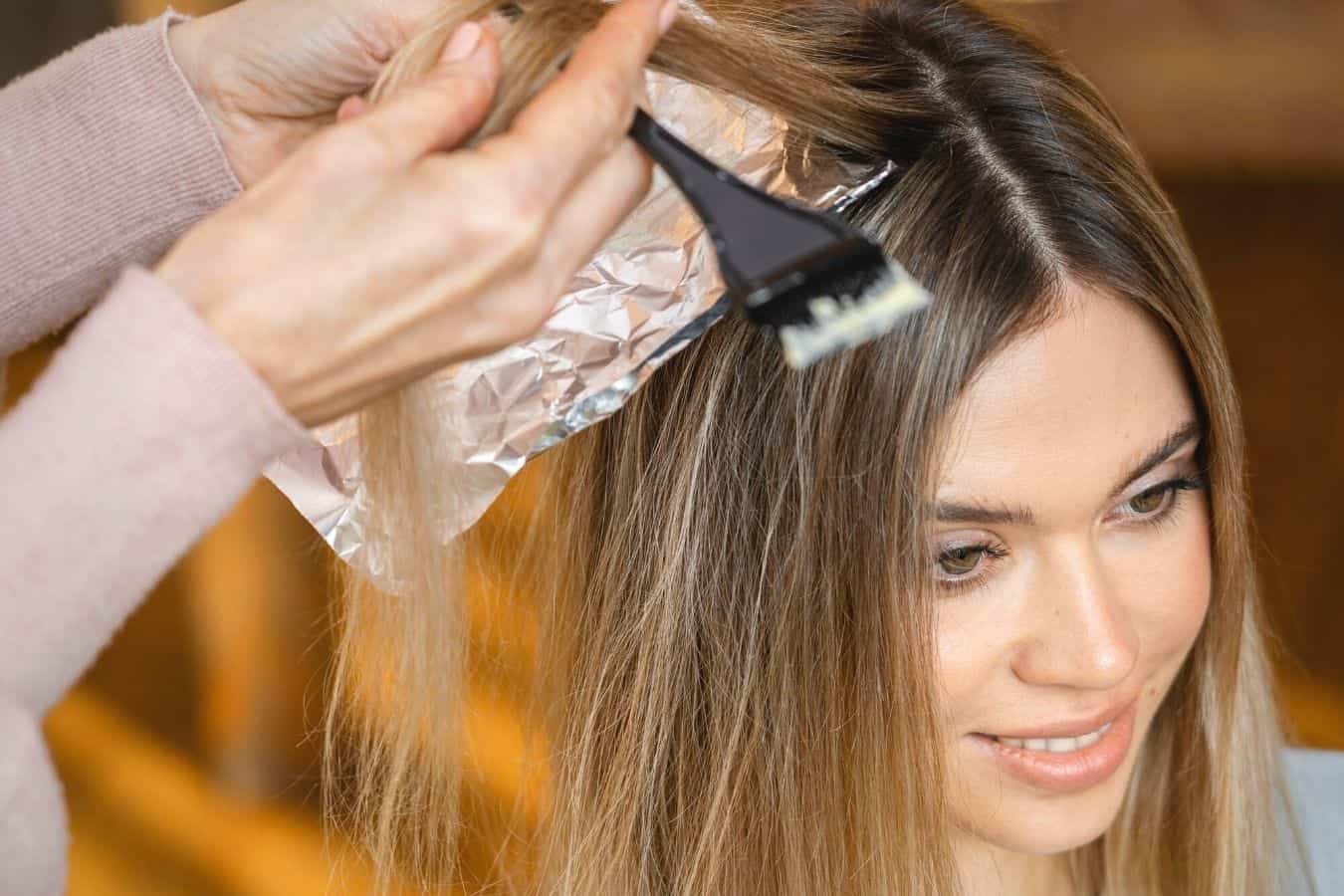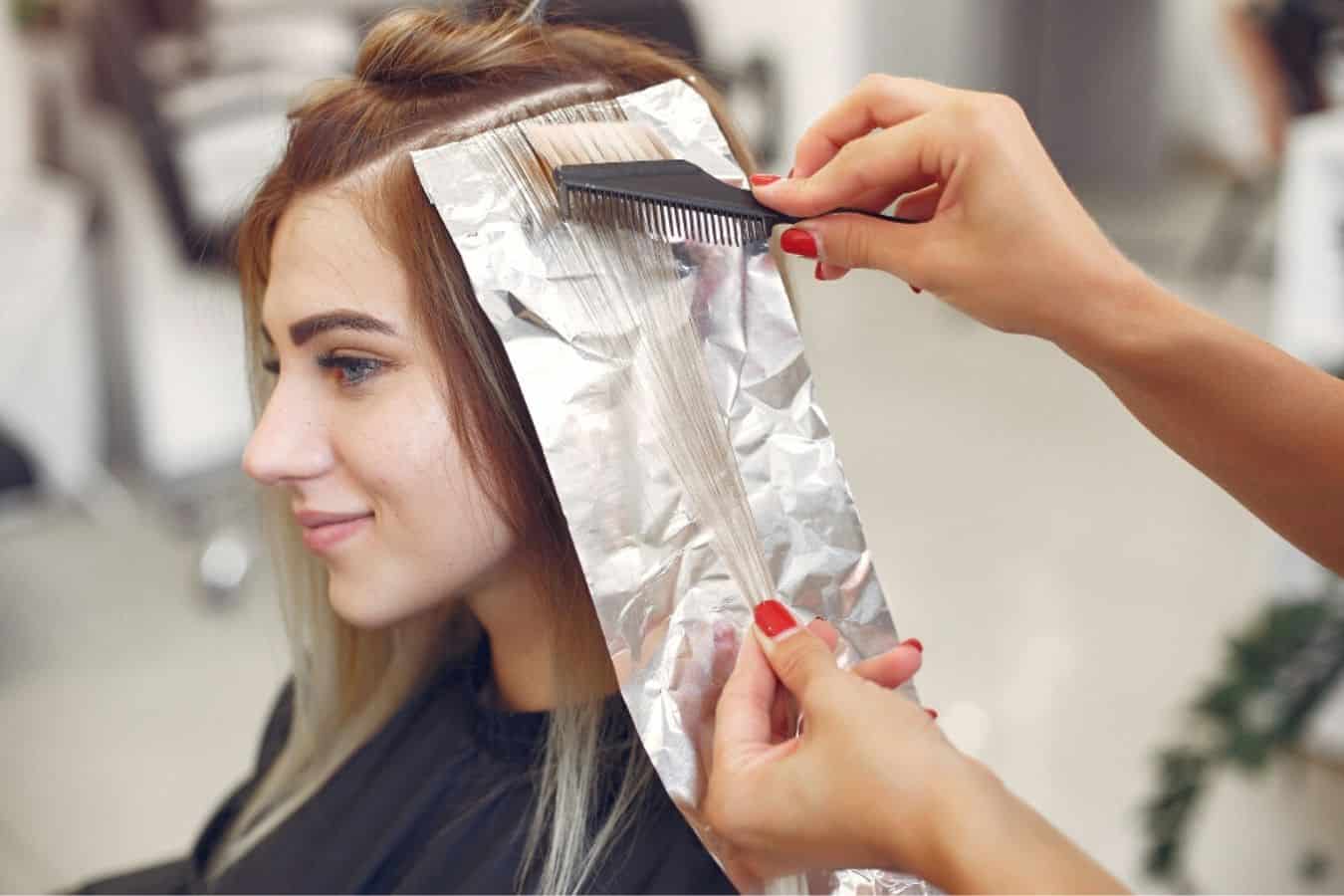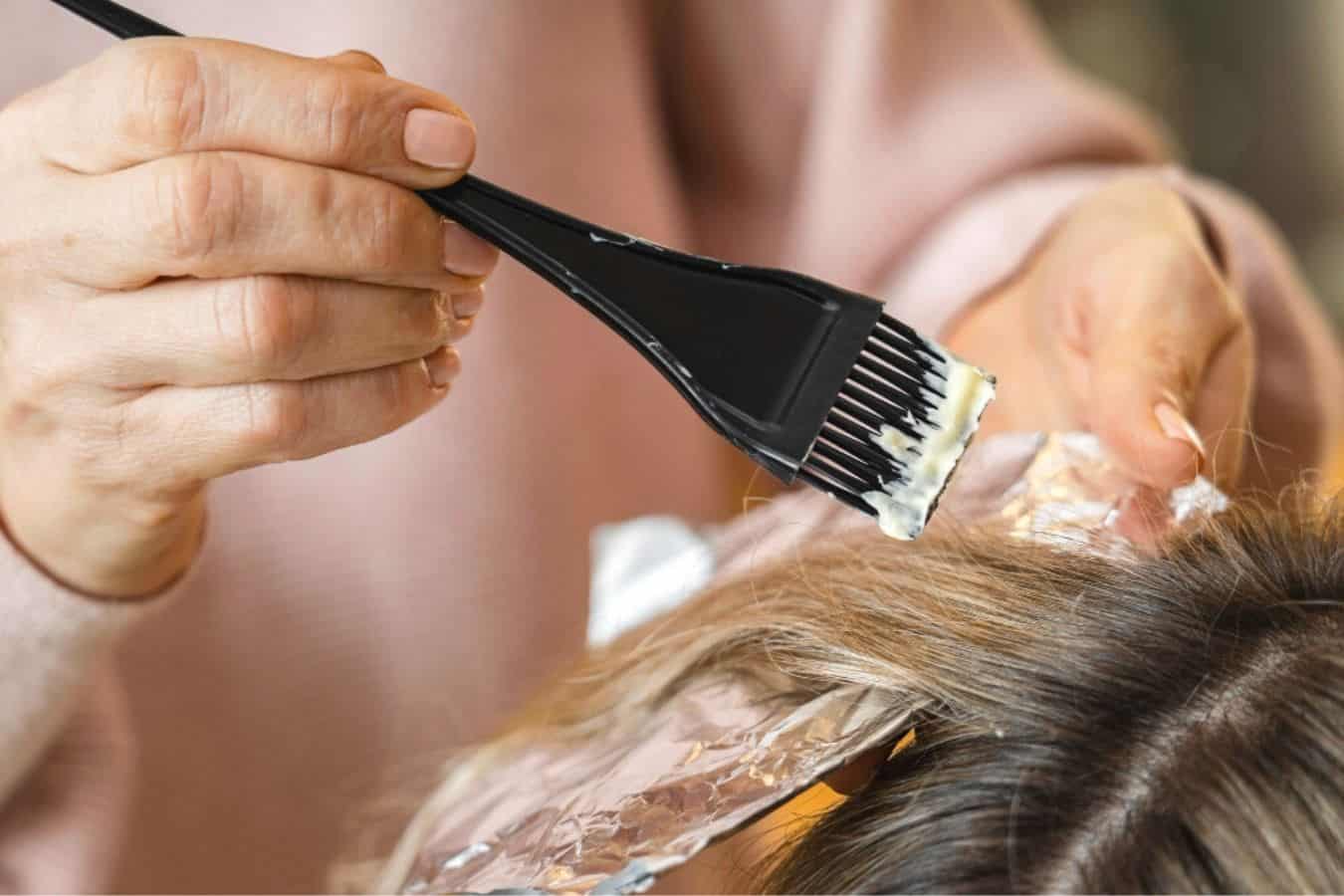We’ve all heard that blondes have more fun. We aren’t here to argue whether or not that’s true, but we are here to let you know how to dye brown hair blonde without bleach.

Bleach is useful for getting your hair blonde, but it’s also incredibly damaging. Thankfully, there are ways to dye brown hair blonde without bleach. You can use either a natural lightener like chamomile tea or lemon juice or a high lift dye.
Why Is Bleach Bad For Your Hair?
Bleach is entirely made up of chemicals.
As such, it’s really harsh on our hair strands. In order to break down the natural melanin pigments within the hair, the bleach has to break apart proteins in the hair strand as the ammonia and hydrogen peroxide oxidizes.
If you don’t take the right precautions, this can leave your hair very dry and damaged, leading to split ends and breakage.
It will also leave your hair very porous, making it more vulnerable to damage from other hazards like heat tools or the sun.
But even if you do use bleach with the right precautions, if you have very sensitive skin, it can still cause a serious reaction.
Bleach can also make hair very brassy looking, giving it an unpleasant sheen that requires the use of toner or purple shampoo to get rid of.
And you’re still putting chemicals onto your body, which can absorb into your skin – and many people just aren’t willing to do that.
Can You Dye Brown Hair Blonde Without Using Bleach?

The good news is that yes, you can dye brown hair blonde without using bleach – and it’s not even too complicated!
There are two main ways to do so. You can use a natural lightener – more on those later – or a product called a high lift dye.
Be aware that both of these will work best on lighter brown hair and dirty blonde tones – and the final look will vary hugely depending on your natural hair color, type, and health.
High lift dyes also won’t work well on hair that’s been colored previously.
A high lift dye works because it contains more ammonia and color pigments than regular dye.
It lifts the hair color without stripping hair of its natural pigmentation, depositing its color on the hair shaft without penetrating and damaging your strands.
High lift dye also does not require an extra toner, unlike bleach, unless you are using it on extremely dark hair, where a separate toner may be necessary.
Be aware that high lift dye might leave you with an overly warm hair color if you misuse it.
When you’re choosing one, you also want to go for an ash tone – no matter what kind of blonde you’re going for.
This is because an ash tone high lift will neutralize any of the less attractive orange or yellow pigments that will likely appear in your hair throughout the lighting process.
A high lift dye can typically only be purchased at salons, too – you’re unlikely to find it in standard drugstores.
Why Your Hair Color History Matters
Your hair color history basically refers to whether or not you’ve previously dyed your hair.
If you haven’t, it will be easier to dye brown hair blonde without bleach, as the natural lighteners or high lift dye won’t have alternative color pigments to contend with.
If you have colored your hair before, the dyeing process will be more complicated.
These color pigments from previous dye sessions are more resistant to the lightening process than natural pigment, sitting in the hair cuticle and thereby increasing the overall pigmentation of your hair.
Using a hair dye remover product will help to make this easier, as you’re removing any dye molecules that might block the effectiveness of either the natural lightener or high lift dye from working.
Things You Should Know Before Using Blonde Hair Dye
There are two main rules to remember before dyeing brown hair blonde without bleach:
- If your hair is naturally darker than light brown, the process might not work as well/you might need to attempt it several times.
- If you have previously colored your hair, you need to strip hair of that color for the natural lightener or hair lift dye to work best.
Remember to always patch test any hair dye before use, so you can be sure you don’t experience any negative reactions.
How to Choose A Blonde Hair Dye

If you’re still keen to use regular hair color to dye brown hair blonde, there are certain things to keep in mind when making your selection.
A general rule of thumb is to choose a dye that’s one level lighter than the shade you’re hoping for.
Like with the high lift dye, ash tones should be in the formula, so that any ugly orange or yellow tones are neutralized during the coloring process.
Remember to keep both your eye color, eyebrow color, and skin tone in mind when you choose a blonde hair dye – would cool or warm tones best suit you?
Remember to buy purple shampoo so as to avoid any brassiness and deeply condition your newly blonde hair.
Keep your hair type, thickness, and porosity in mind, too. You need to know how the color of your hair will likely react to the dye.
If your hair resists color because of its porosity or type, you may need to go with a darker shade – alternatively, if your hair takes dye easily, going a shade lighter is probably best.
Remember that your hair needs moisture. It’s not only beneficial for your hair’s overall health, but it will also keep the dye lasting far longer.
Using a UV-protectant will also keep the sun’s rays off your tresses, helping to prolong color.
Natural Ways To Lighten Hair
These are the three main natural lighteners that you can use in order to dye brown hair blonde without bleach. We describe how to use them on a step-by-step basis below.
Lemon juice: Lemon juice contains many acids that work to lighten your hair without bleach.
Honey and vinegar: You can use honey and vinegar in combination with cinnamon and olive oil to turn your hair lighter.
Chamomile tea: It needs to be strong, but rinsing your hair with chamomile tea can lighten it.
You can use vitamin C if none of the above works for you, but it’s not the best option, as it can cause scalp dryness and itchiness, or inflammation.
If you’re prone to sensitivities, it’s definitely best to steer clear.
The sun is also a major hair lightener.
This obviously can’t be applied in the same way as any of the above three lighteners, and the UV rays of the sun will damage both the melanin and keratin in your hair, so can cause serious dryness and breakage.
It’s, therefore, best not to rely on the sun on as a source by which to turn brown hair blonde without bleach.
There are many spray-in lighteners available, but be sure to double-check their ingredients, as some do contain bleach.
How to Dye Brown Hair Blonde Without Bleach
Using these natural lighteners regularly will help keep your brown hair blonde without the use of bleach for as long as possible. You can spritz the mixtures onto dry hair in between washes for longevity.
Lemon Juice
- Try to use freshly squeezed lemon juice, or the best you can get from a bottle. How much you’ll need is contingent on your hair length and thickness, as well as whether you’re trying to color your whole head of hair or just highlight sections. Aim for at least two cups of lemon juice.
- Mix two parts lemon juice with one part water in a spray bottle. If you’re hoping to lighten all your hair, spritz it all over and use a non-metal comb or brush to evenly distribute it. Be cautious of your eyes or any cuts you have.
- If you are only highlighting, separate your hair into sections and use either your fingers or cotton wool to rub the lemon mix into your hair.
- Use heat to activate the lemon – a blow dryer will work or some sun (but not too much! And always use sunscreen).
- Repeat as often as necessary, but be aware that lemon will dry your hair, so you’ll likely need to follow this with a deep conditioning treatment.
- If your hair is too brassy, you can use tomato paste to tone it down. Yep, sounds a little gross, but it’s a natural way to remove any of these brassy tones. Just remember to wash your hair thoroughly after use.
Honey and Vinegar
- Grab two cups of vinegar with one cup of raw honey. Add a tablespoon of olive oil and a tablespoon of cinnamon. Mix thoroughly to ensure the ingredients are combined.
- Apply the mix to damp hair using either your hands or a comb. If you’re only highlighting your hair, section it first and then apply the mix with your fingers.
- Pop on a shower cap or wrap your hair in saran wrap. Leave the cap on overnight as you sleep, and rinse the mix out in the morning.
- You may need to repeat the process, and remember to follow with a deep moisturizer or conditioning treatment.
Chamomile Tea
- You’ll preferably be using chamomile flowers, but you can use an organic chamomile tea if you can’t find these. You also need the juice of one lemon, a teaspoon of raw honey and two tablespoons of apple cider vinegar.
- Take three heaped teaspoons of the chamomile flowers and add to three cups of water. Boil up and leave to brew for ten minutes.
- Leave the dark yellow mixture to cool – you need to be sure you won’t burn yourself when you apply it.
- When totally cool, add the lemon juice, honey, and vinegar. Stir up.
- Strain the mix and distill into a spray bottle – using a funnel will make this easier.
- Spray onto your whole head of hair or sections, depending on your preference. Cover your hair with a shower cap and leave overnight.
- Rinse out the following morning, and repeat as necessary. Remember to moisturize your locks once you get your desired tone.
Like this? Check out our article on apple cider vinegar and its effect on hair color.
Disclaimer: This site is not intended to provide professional or medical advice. All of the content on LovedByCurls.com is for informational purposes only. All advice should be followed at your own discretion. Ingredients may change at any time so always check the product label before using. Check our full disclaimer policy here.
